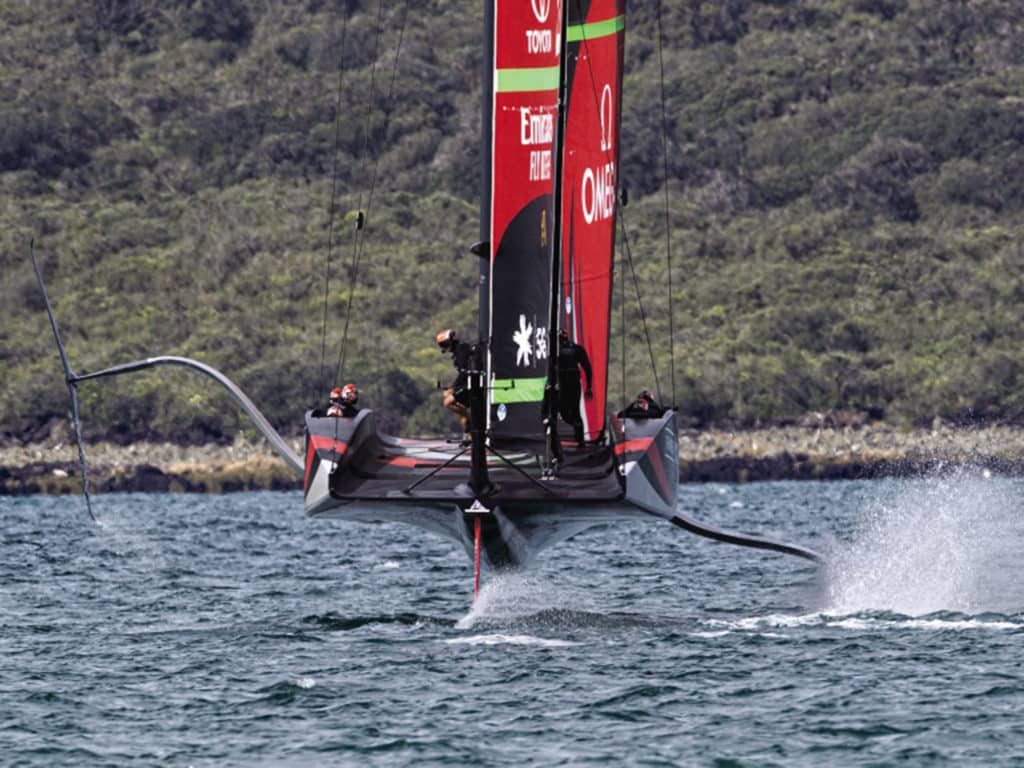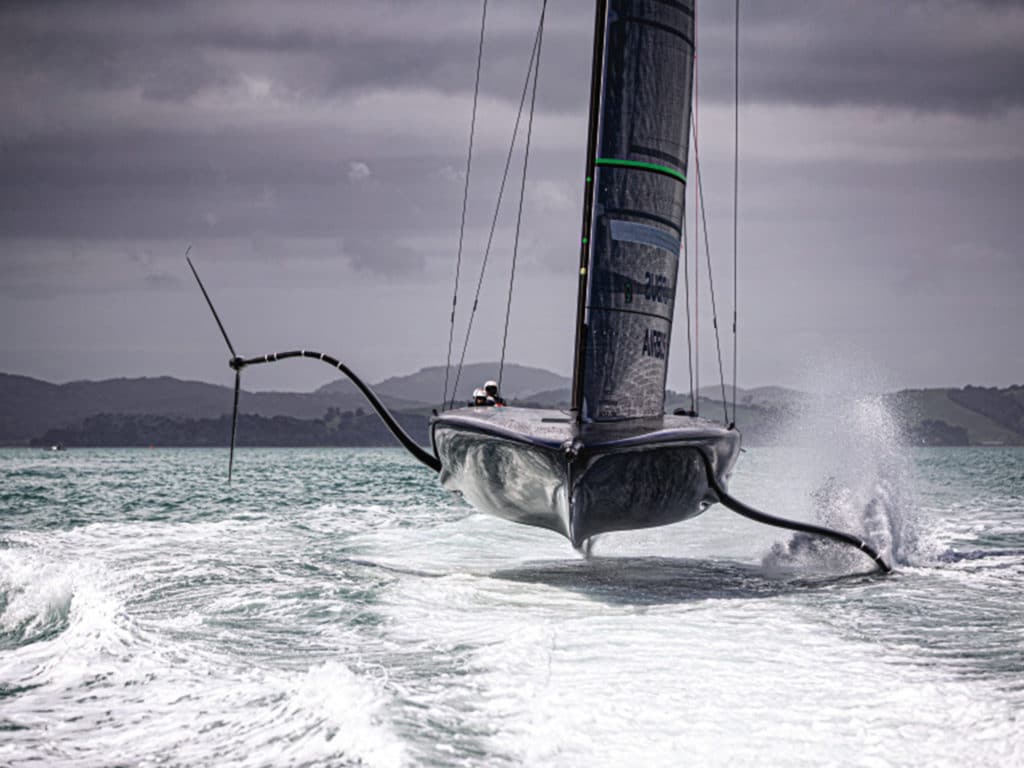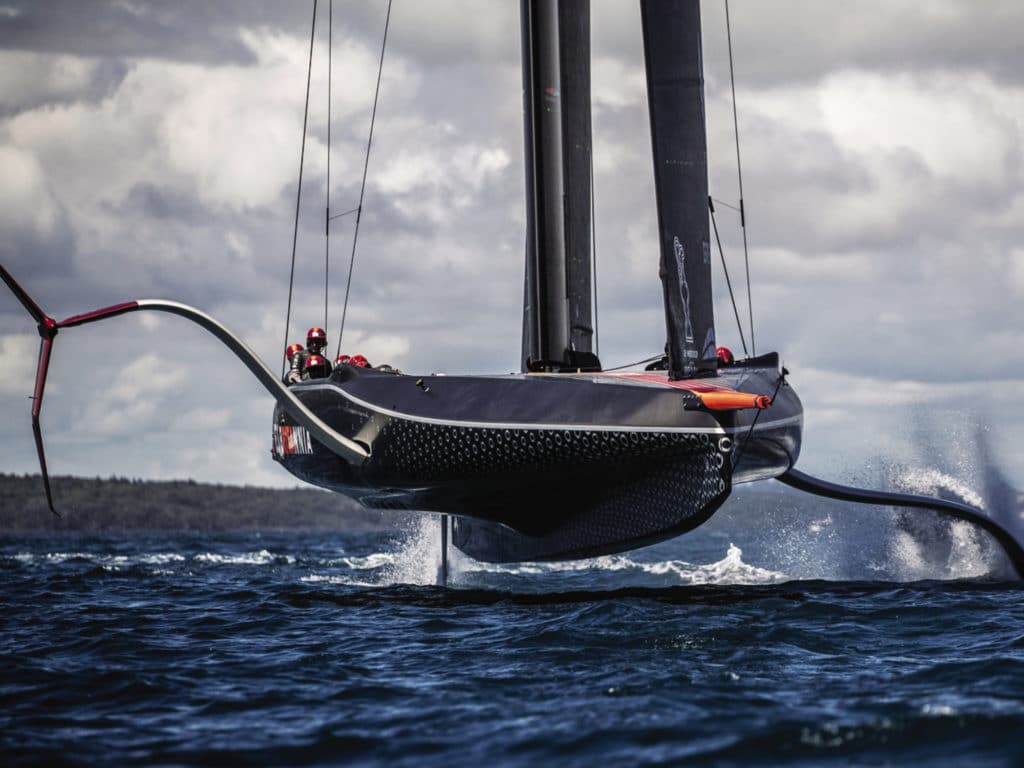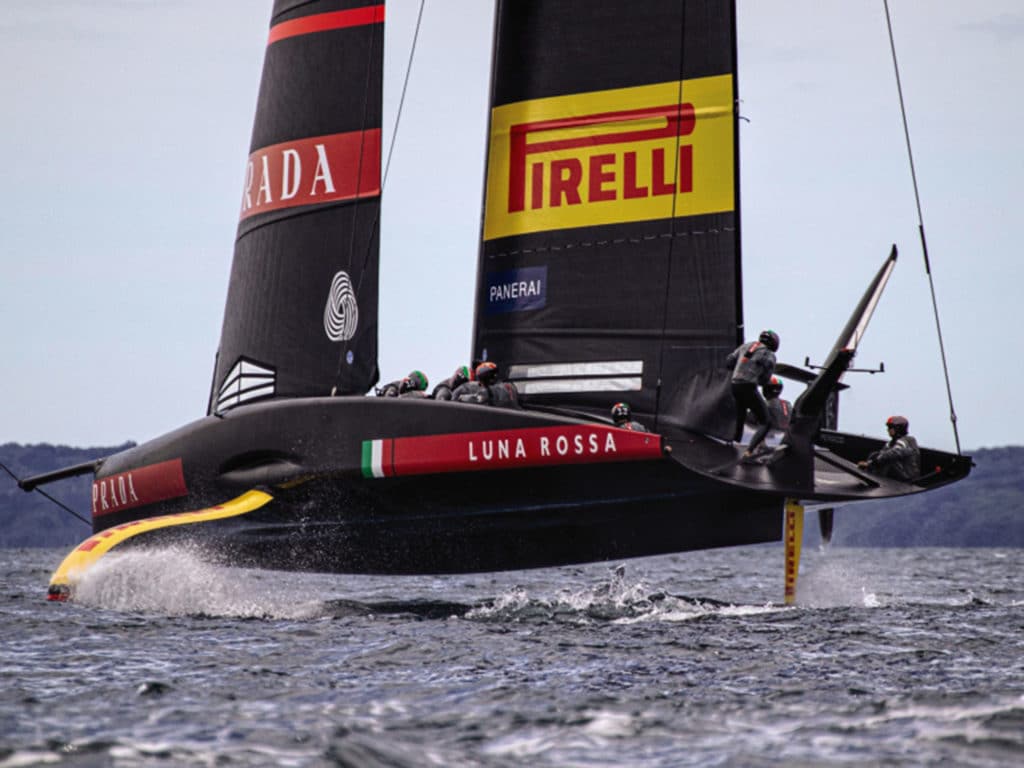Hull design has always been the most venerated aspect of an America’s Cup yacht. The name on the drawings has often been remembered with the same reverence as that of the skipper. This might not hold for much longer because the result of the 36th America’s Cup is just as likely to be determined by the work of a systems engineer as by a naval architect.

“The hull design is one aspect of many, but it’s not the dominant aspect,” explains Martin Fischer, co-design coordinator (along with Horacio Carabelli) for the Luna Rossa Prada Pirelli Team, who is on his second America’s Cup with the Italian team. “It’s not as it was with the 12 Metre or with version five (of the International America’s Cup Class), where the hull is really almost everything.”
The rules controlling a class are always a good place to start when seeking to understand a race boat because they drive so much of the design; working for the Challenger of Record, Fischer was part of the team that wrote the class rule for the AC75 with the defenders, Emirates Team New Zealand.
In the case of the AC75, the rules, Fischer says, are actually very open. They have little to say on the structure, for instance, requiring only a “minimum areal density of any part of the hull shell” (2 kg/m²). There’s also a limit on the internal volume (at least 70 m³), and after that, much of what’s left deals with details such as water retention, fairing flaps and penetrations.
There are only a few rules that drive the hull shape and its potential performance. “There is the length,” Fischer says. “The overall length is limited to 20.6 meters (minimum, without the bowsprit), while the beam must be 5 meters. Then there are two other very important rules: There is a theoretical capsize test that is done virtually on the computer. If the boat is turned by 90 degrees, the center of buoyancy must be at a certain position.

“This rule has a strong influence on the deck shapes. You might have noticed that all the boats have relatively high freeboard; this is partly for aerodynamics, but also, if you don’t have relatively high freeboard, you don’t pass this capsize test. The next important rule is that there is a minimum requirement for the waterplane inertia.”
Er…the water what?
“If the hull is floating, then you look at the intersection of the hull with the water surface (waterplane), and that gives the surface a certain shape. And then compute the inertia of that shape (it must be at least 20 m4). It’s not important to understand exactly what it is; in the end, it is more or less a measure or a constraint on the combination of that surface and its width.”
I’m not going to try to explain the calculation of the “second moment of area”—the important thing, according to Fischer, is that you “basically cannot make an extremely narrow hull, so you have to respect a certain area for that surface, and a certain width. The rule on the inertia is also quite type-forming; it imposes widths at the waterline. Of course, we all would like [the hull] to go narrow. Especially when the boat starts going fast, just before takeoff, we all want a narrow hull. And this is why we have these humps underneath the hull.”
Ah yes, the humps, skegs or bustles are one of the most significant shared features on all four of the newly launched, second-generation AC75s. The terms refer to the narrow, protruding section that runs down the centerline underwater. In the first-generation boats, only the Kiwi and Italian boats had this feature, and it was most pronounced on the latter.
“It’s a trick not to get around this inertia rule but to deal with it,” Fischer explains. “What you do is design a hull wide enough to pass this inertia rule while it is at the design flotation. And then as soon as it gets a bit of speed, the foil starts pushing up, and so the boat comes up, and then this wide part of the hull gets out of the water and only the narrow part remains. This significantly reduces the drag, especially during the takeoff phase.”

The humps also help when the boat touches down. “And that’s another reason for these humps underneath, because they allow you to fly lower, to take more risk, because if you touch a wave, the wetted surface, or the area that touches the wave, is very small, and therefore it slows you down only very little.”
Benjamin Muyl is on his second Cup with Ben Ainslie’s British challenger, having been involved in the event since 2005. Now the architect, he sums up the factors driving the performance of the AC75: “As soon as we decided that these boats are only going to race in flying (foiling) conditions, then there’s no point in having any righting moment from the hull. The whole righting moment comes from the foil, so then the hull shape is all about takeoff capabilities, so effectively [acceleration and performance at] slowish speed, in the order of 16 to 20 knots—the touchdowns. So, the ability of the hull to develop little drag when touching the water at speed or out of tacks, or out of jibe. And the other part of it, which is actually very important for these boats, is the aerial performance of the hull.”
This is the reason all four boats have skegs; they provide a benefit in all three areas that Muyl and Fischer describe. They enable better acceleration at slower speeds, and reduce the hydrodynamic drag and deceleration on touchdowns. This allows the boat to fly closer to the water, which has another important aerodynamic contribution. “On every wing, you have a high-pressure side and a low-pressure side,” Fischer explains. “And obviously, the air tries to flow from the high-pressure side to the low-pressure side, and if you let it do that, you lose lift. On a normal sailboat, this circulation that makes you lose lift is at the bottom, underneath the boom, and this loss is quite significant. To avoid that, on all the [AC75] boats, we see deck sweeper sails.”
Muyl worked with both Fischer and ETNZ’s Guillaume Verdier on Franck Cammas’ Groupama 5, the International C-Class Catamaran Championship winner. It should be no surprise, therefore, that their thinking is aligned here. “In recent years, we’ve seen sails and wings extend to seal to the deck. It pretty much started with the Groupama C-Class boat for Cammas. And then that was also seen on the AC72, and since then all the Cup boats have the mainsail sealing on the deck. On these boats (the AC75), for the first time we have a monohull that’s flying. So, what’s happening is that now there is a gap again, so we pushed to effectively seal the hull to the water.”
It’s impossible to completely seal the hull to the water without increasing the hydrodynamic drag, and even maintaining the minimum distance is made harder by waves. “So, even if you had perfect control of the boat, it would be impossible to close that gap completely. But [the teams] make big efforts to close that gap as much as possible,” Fischer says.
“We spotted [the performance effect of sealing the gap] early in the project,” Muyl adds, “and always questioned whether it was a true phenomenon, or whether it was an artifact of the computation. We finally made the call to go there to try to achieve it. It’s interesting to see that all the boats have gone there now. So, yes, we followed the same path. It was done with different means between the various teams, but we went for this very squared bustle to try to create a vortex off the sharp edge that would effectively seal [the gap].”
When we look at the four new boats, it’s clear there is significant agreement on what makes for a fast AC75. The skegs are the most obvious element, but an aerodynamic hull shape is a close second. The speed of the boats drives this one, with apparent winds that can easily exceed 40 mph.
“If you stick your hand out of a car when you’re driving at that speed, you feel how big this drag is,” Fischer says. “This drag component is comparable to the drag we see in the water. All the teams have paid enormous attention to this; they hide the crew as much as they can, and have the shape of the hull as aerodynamic as possible, to reduce drag as much as possible.”
If looked at sideways from the beam, all the second-generation hulls reveal an aero foil section from bow to stern—don’t be fooled by the high sides of the Kiwi’s crew pods. Fischer explains: “It is hidden because [ETNZ has] these relatively high cockpits on the side to cover the crew. But in between the cockpits, the shape is pretty much like an aero foil. The American boat also has a pretty nice aero foil shape, and as well, the British boat. I think the only main difference is that on our boat, it’s a bit more obvious, but the others have more or less the same idea.”
The third consistent element is the split cockpit. “The cockpits were pretty much the same everywhere at the beginning,” Fischer says. “All the teams have cockpits on each side, with the crew well-protected from the wind to reduce drag. Also, the Americans at the beginning had the cockpit very far aft. Now they are farther forward. So overall, I think we can see quite a bit of convergence, but there’s still a wide variety.”
The variety in the boats is driven by the details, and they will decide the winner. For instance, there are significant differences in the skegs, which shouldn’t be a surprise given there are three different motives for having the skeg in the first place. “The optimal shape for these purposes is different,” Fischer says. “If you focus on aerodynamics, then you want a pretty narrow hump, because if you touch down, the wetted surface is really small, and so you can fly lower. The penalty you pay, if you touch a wave, is less than with a wider hump. But with a narrow hump, you have difficulties in takeoff because the volume in such a narrow hump is very small, and you need a lot more lift from the foil to get the flat part—the wide part of the hull—out of the water.”
The choices the teams have made reflect the capabilities they have prioritized for the upcoming racing. “The Kiwis and the British have a wider hump underneath, which is pretty flat at the bottom,” Fischer says. “So, in my opinion, they try to generate positive lift when they touch, and probably also during takeoff. Of course, if you generate lift when you touch, that comes at a price —you also generate drag.”

Muyl agrees, adding: “[It’s] not forgiving if we touch because there’s quite a lot of wetted surface area to start with. So, effectively, we are relying quite a lot on the ability of the sailors to control the boat and to fly it just above the free surface.”
“American Magic has a very narrow hump,” Fisher says. “So, in my opinion, they’re focused more on aerodynamics and flying low than on takeoff.”
Or maybe they want the best of both worlds. Muyl points to a different takeoff technique. “Their strategy to takeoff is to accelerate as well as they can, but then, when they are at the speed to takeoff, somewhere between 16 and 19 [knots], they force the nose up with their rudder, and effectively increase the angle of attack on the foil and takeoff like that.”
American Magic’s designer, Marcelino Botin, wasn’t giving much away at this stage. Speaking at the launch of Patriot, he said: “We’ve got a philosophy of the boat that we need, and the boat we have produced is our interpretation of the best possible boat to take forward that way of thinking.”
And the Italians? “Our hump is more rounded, and I would say ours is somewhere in between what the Americans did, and what the British and Team New Zealand did,” Fischer says. “So that’s a choice. When you design the yacht, you have to make assumptions and define conditions for which you want to optimize your shape.”
The winning design will need both the most accurate set of assumptions about the competing priorities, and efficient optimization. Easy to say, but there is nothing straightforward about this process, as Muyl explains: “I find this boat really complex, in terms of how everything is so interlinked. If you look at just the foils, we have [in the fleet] some very large bulbs and some very small bulbs—the whole scope. So, that’s interesting that four teams of competent people with comparable tools, with comparable budget and time, effectively reached some very different solutions in the end. I personally found it very hard to have a feeling for what’s the direction to go to be faster. The whole thing is incredibly intertwined. I find it very complex. And that’s at every level of the design.”
Fischer agrees, adding: “This kind of hull was new for everybody, and basically, everybody had to start from scratch and find new ways. And I can say, I don’t know what the others did, but we went for a very mathematical approach to get there. We used, right from the beginning, a dynamic simulator.
“We used systematic, automatic optimization methods to get to the hull shape that we got in the end. And I think without this mathematical approach, it would have been very, very difficult. And I guess for the other teams, it’s the same. I think it is very difficult with these boats to get to a good result with pure intuition.”
Now that they can see where they fit into the fleet, how do they feel?
“Well, I think we don’t really know,” Muyl says. “We have a feel for New Zealand. I mean, they won the last one. They gave a sailing lesson to everyone. So, they are usually strong, but so much is about reliability that I find it really hard to have a sense that I can trust about where things are.”
Fischer was more guardedly optimistic about the Challenger’s chances. “I think as usual, [ETNZ] did a good job, but I don’t think they…well, I hope they won’t be superior, and I don’t think they will be superior. I think it will be pretty tight racing.”









